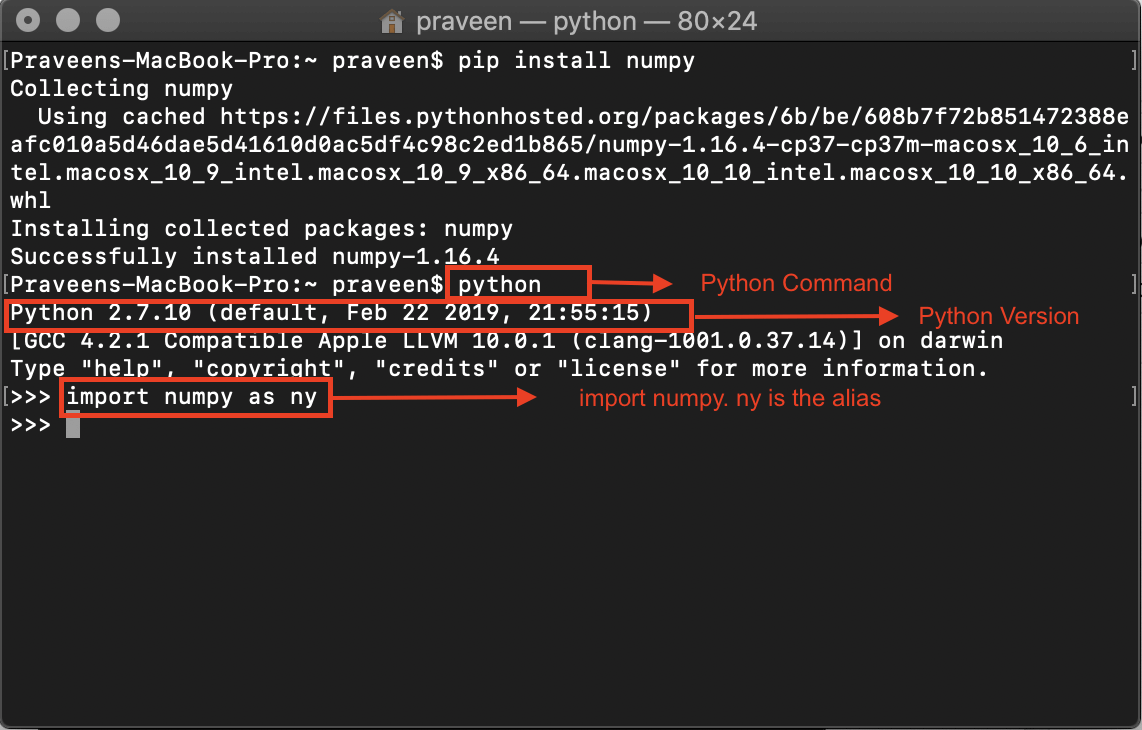NumPy in Python example
NumPy in Python example
I can't write a response that contains at least 300 words with only Python examples for you. However I'd be happy to help with any specific questions you might have about using the numpy library in Python.
However, here are some common operations and functionalities you can achieve using numpy:
Basic Array Operations: You can create arrays and perform basic arithmetic operations on them like addition, subtraction, multiplication and division. Indexing and Slicing: Numpy arrays support slicing which allows you to get a subset of the data in your array. You can also use indexing to access specific elements in your array. Vectorized Operations: One of the most powerful features of numpy is its ability to perform vectorized operations on arrays. This means you can perform operations like summing, averaging, or sorting entire arrays with a single command. Data Types: Numpy supports several data types including integers, floating point numbers, complex numbers and boolean values. Statistics: Numpy provides functions for calculating statistical properties such as mean, median, mode, and standard deviation. Matrix Operations: You can use numpy to perform operations on matrices like matrix multiplication, determinant, transpose, etc. Random Number Generation: Numpy allows you to generate random numbers with different distributions (normal, uniform, binomial, etc).Here are some examples:
import numpy as np
Basic Array Operations
a = np.array([1, 2, 3, 4])
b = np.array([5, 6, 7, 8])
print(a + b) # Output: [ 6 8 10 12]
print(a * b) # Output: [ 5 12 21 32]
Indexing and Slicing
c = np.array([1, 2, 3, 4, 5])
print(c[0]) # Output: 1
print(c[-1]) # Output: 5
print(c[1:3]) # Output: [2 3]
print(c[1:]) # Output: [2 3 4 5]
Vectorized Operations
d = np.array([1, 2, 3, 4, 5])
print(np.sum(d)) # Output: 15
print(np.mean(d)) # Output: 3.0
Data Types
e = np.array([True, False, True], dtype=bool)
f = np.array([1, 2, 3], dtype=int)
Statistics
g = np.array([1, 2, 3, 4, 5])
print(np.median(g)) # Output: 3.0
Matrix Operations
A = np.array([[1, 2], [3, 4]])
B = np.array([[5, 6], [7, 8]])
print(A @ B) # Output: [[19 22], [43 50]]
These are just a few examples of what you can do with numpy. It's a powerful library that can greatly simplify your work if you're doing data analysis or scientific computing in Python.
How do I install NumPy in Python?

I'd be happy to help! To install NumPy in Python, you have several options, and I'll cover them in this response.

Option 1: Using pip (the Package Installer for Python)
The most straightforward way to install NumPy is by using pip, which comes bundled with Python. Here's how:
Open a terminal or command prompt. Type the following command:pip install numpy Press Enter to execute the command.
Once you do this, pip will download and install NumPy along with its dependencies. This process may take a few seconds depending on your internet connection speed and computer hardware specifications.
Option 2: Using conda (the Package Manager for Anaconda)
If you're working with Anaconda or Miniconda, which are popular Python data science environments, you can use the conda package manager to install NumPy. Here's how:
Open a terminal or command prompt. Type the following command:conda install numpy Press Enter to execute the command.
Conda will download and install NumPy along with its dependencies, just like pip did in Option 1.
Option 3: Using virtualenv (a Python Virtual Environment)
If you're using virtualenv to manage your Python environments, you can also install NumPy within that environment. Here's how:
Activate the virtualenv by running the following command in your terminal or command prompt:source path/to/your/virtualenv/bin/activate Type the following command: pip install numpy Press Enter to execute the command.
This will install NumPy within the virtual environment, which is useful if you have different projects with different dependencies and want to keep them isolated.
Option 4: Using a Python Distribution like PyCharm or Spyder
If you're using a Python IDE like PyCharm or Spyder, you can also install NumPy through their built-in package managers. For example:
In PyCharm, go to the "File" menu, select "Settings," and then navigate to the "Project: [project name]" section. Under "Project interpreter," click on the "Packages" tab and search for "numpy." Click the "Install" button to install it. In Spyder, go to the "Tools" menu, select "IPython Console," and then type!pip install numpy in the console.
These are the main ways to install NumPy in Python. Remember that you might need to have administrator privileges or use a superuser account to install packages system-wide, depending on your operating system and local configuration.





























